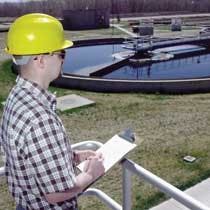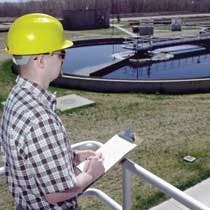by Bob Dabkowski
Continuous phosphate monitoring can help eliminate alum under- and overdosing while supplying useful trend data for evaluating the overall treatment "picture" at a wastewater treatment plant
Phosphorous removal through chemical and physical methods can only take place when the phosphorous is in the orthophosphate form. Most biological wastewater treatment processes naturally convert organic and condensed phosphates to orthophosphate. The orthophosphate can then be precipitated into salt particles through treatment with alum, lime, or iron salts. When one or more of these chemicals is added, the smaller particles flocculate into large masses. The flocculated particles settle in the sedimentation tank, adding to the sludge.
This process can reduce the concentration of phosphate by more than 95 percent, making it possible for the effluent to remain well within permit limits. However, chemical overtreatment raises operational costs and can lead to a significant increase in sludge volume. Undertreatment creates a serious risk of non-compliance and can adversely affect water quality.
The effectiveness of biological removal methods is also subject to changes in the phosphorous concentration. Without reliable, real-time information about current phosphorous concentrations, operators are often forced to err on the side of caution when determining chemical dosages.
Phosphate Analyzer
A number of facilities have begun using a relatively new type of phosphate analyzer that allows operators to instantly check phosphorous concentrations at critical points in the wastewater treatment process. The Hach PHOSPHAX™sc Phosphate analyzer is typically installed just prior to filtration or at the final effluent, or both. Changes in the phosphate levels are indicated by colorimetric values and then converted to mg/l units for display.
Prior to each measurement, the self-cleaning analyzer determines the intrinsic color of the wastewater so that results are not distorted. One of the analyzers was recently installed at the Julington Creek WWTP in northeast Florida and has made a positive impact on phosphorous removal treatments.
Dosing Issues
The 1.0 mgd Julington Creek WWTP serves the 4,200-acre Julington Creek planned community in south suburban Jacksonville, close to the east bank of the St. John's River. The Jacksonville Electric Authority (JEA) operates the facility.
Built in the early 1990s, the Julington Creek development needed an on-site wastewater treatment plant to treat municipal wastewater and re-use the filtered wastewater for golf course irrigation. At that time, the influent biochemical oxygen demand (BOD) averaged 180 milligrams per liter and the suspended solids averaged 160 mg/L. The plant had to handle about 1,600 homes initially, and as many as 6,500 homes would be built over the next 15 years as the community expanded.
A few years ago the plant underwent a conversion to enable nutrient removal. When demand for irrigation water decreases seasonally, the water is dechlorinated and discharged to the St. John's River. Here, the effluent is subject to strict discharge standards, including a phosphate limitation of 3.0 mg/l. Taking no chances, the staff at the Julington Creek WWTP aims for a phosphorus concentration of 1.0 mg/L or less.
Alum is used to precipitate the phosphorous at the facility, one of JEA's two wastewater treatment plants that incorporate nutrient removal. Determining the correct dosage at any given time was difficult before the analyzer was installed. The plant was going from one extreme to the other, either underdosing or overdosing. Without the aid of the analyzer, operators were forced to feed a "precautionary" amount of alum that was often in excess of the actual amount needed for effective phosphorous removal.
The final effluent from the Julington Creek plant does not require chemical treatment for phosphorous removal when it is being used for irrigation purposes, because the plant's land application permit does not call for nutrient monitoring.
"The water goes to the golf course and to the Property Owners Association for re-use on the medians and right of ways," said John Sgambettera, lead operator at the plant. "During the months when the effluent is discharged into the river, however, accurate phosphorous monitoring is one of the most critical elements in our treatment process."
Analysis Process
With the installation of the PHOSPHAXsc analyzer, operators now adjust the alum dosing pumps until the analyzer reading falls to around 1.0. Installed directly on the side of the tank near its monitoring point, the analyzer samples just prior to flows entering the plant's pulsed-bed sand filters. With dosage based on the analyzer's readings, alum is added just ahead of the facility's two clarifiers. Prior to each measurement, the analyzer is flushed with sample to remove any residual fluids, and the natural coloration of the sample is measured to obtain a zero calibration.
Following Standard Methods, the PHOSPHAXsc instrument relies on the vanado-molybdate yellow colorimetric method. When the reagent mixes with each fresh sample, a change in color intensity indicates the presence of orthophosphate. The concentration is displayed in mg/l on an LCD panel located on the face of the SC1000 Controller. After the sample has been processed, the system automatically drains all fluid in preparation for the next measurement cycle.
Simple Design
Compared to other nutrient monitoring systems, the PHOSPHAXsc analyzer uses relatively little reagent, a feature that helps keep operating costs down. The unit operates with no wetted moving parts. Only the tubes come in contact with the sample. Further, the tubing, internal parts and reagents are easy to see and replace when needed.
Each unit is shielded from weather, temperature extremes and other potentially detrimental conditions inside a weatherproof, insulated housing that maintains its own temperature control. The samples are unaffected by external conditions so that measured values are consistently reliable.
Response time for the analyzer is only five minutes, including sample preparation, and the operator can choose the measurement interval. The analyzer is continuously read by a Hach sc1000® Universal Controller that communicates via a 4-20mA signal to the plant's SCADA system. The controller has a built-in datalogger that collects measurements, along with calibration and verification points, alarm history, and instrument setup changes for up to six months. The controller is designed to receive data from up to two sensors simultaneously. The additional port provides the plant flexibility for adding a second probe for gaining broader parameter measurements, such as suspended solids, dissolved oxygen, or pH, by simply plugging in the appropriate sensor.
Operators manually regulate the amount of alum dosed based on the readings from the PHOSPHAXsc analyzer, and Sgambettera says that alum usage is now more efficient because the plant is no longer overfeeding as a precautionary measure. An option for the plant in the future is for the alum pumps to be controlled automatically based on the current reading.
About the Author:
Bob Dabkowski is a Wastewater Specialist for Hach Company and a Licensed Colorado Wastewater Operator. He is the author of several papers, articles, and application notes concerning wastewater treatment and has over eight years experience at Hach, advising process control & automation solutions. [email protected].




